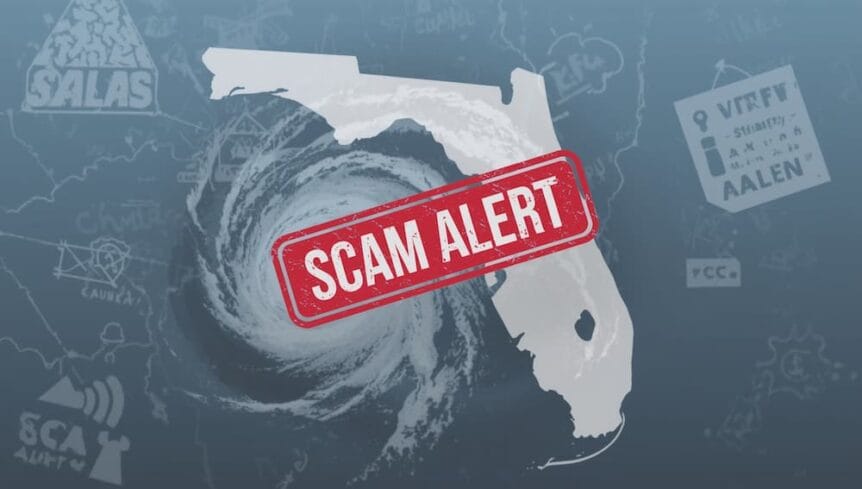Florida companies face unique challenges when it comes to charitable giving. While corporate philanthropy strengthens community ties and fulfills social responsibility goals, it also makes organizations prime targets for sophisticated charity scams. With hurricane season, holiday giving, and year-round fundraising appeals, the business community must balance generosity with vigilance.
The Growing Threat of Charity Scams
Charity fraud has become increasingly prevalent across the state, with organizations often targeted due to their greater financial capacity and desire to support local communities. Following major hurricanes and during holiday seasons, fraudulent charity schemes surge dramatically, exploiting the goodwill of donors statewide.
The financial impact extends beyond the lost donation; companies that fall victim to these scams often face additional consequences including reputational damage, potential tax complications, and vulnerability to further security breaches. Scammers who successfully extract donations frequently gain valuable information about a company’s financial processes, potentially opening the door to more serious cybersecurity compromises.
Florida’s Attorney General’s office reports that charity scams consistently rank among the top fraud categories affecting residents and organizations, with millions lost annually to these schemes. The problem has grown so significant that new legislation has been enacted requiring increased transparency from organizations soliciting donations in Florida.
Common Charity Scam Tactics
Fraudsters recognize that corporate donations are typically larger than individual gifts, making companies especially lucrative targets. They’ve developed sophisticated techniques specifically designed to exploit corporate giving programs and bypass standard verification procedures.
Fake Disaster Relief Organizations
Florida’s vulnerability to hurricanes and other natural disasters creates perfect opportunities for scammers. Following major weather events, fraudulent organizations emerge overnight, creating professional-looking websites and outreach campaigns claiming to support recovery efforts.
These operations often use names deliberately similar to legitimate relief organizations, such as “Florida Hurricane Relief Fund” instead of established organizations like the Red Cross or Salvation Army. Their solicitations typically emphasize urgent needs, claiming immediate funding is required to help victims, thereby pressuring decision-makers into quick action without proper verification.
One particularly insidious tactic involves creating fake testimonials from “local businesses” that have already contributed, attempting to establish legitimacy through fabricated peer endorsements. They may even include stolen logos from well-known companies to strengthen their deception.
Government Agency Impersonation
Government impersonation scams target organizations through calls or emails from individuals claiming to represent FEMA, the Florida Division of Emergency Management, or other official agencies. These scammers typically claim they’re coordinating private-sector donations for disaster relief or recovery programs.
A common variation involves claims about government matching programs, where companies are told their donations will be matched by federal or state funds if they act quickly. They often request “processing fees” to unlock these matching funds, a telltale sign of fraud since legitimate government programs never require such payments.
Legitimate government disaster assistance programs never solicit donations directly from companies. If you receive such requests, independently verify by contacting official agencies through their published contact information, not through links or phone numbers provided in the solicitation.
Social Media and Email Solicitation Fraud
Professional networking platforms like LinkedIn have become fertile ground for charity scams targeting executives. Scammers create fake profiles mimicking nonprofit directors or community leaders, then build relationships with business owners before launching fraudulent fundraising appeals.
Email campaigns have grown increasingly sophisticated, with perfect replicas of legitimate charity communications, including stolen logos, similar domain names, and professional design. These emails often include links to fraudulent donation pages that capture not only financial information but potentially corporate credentials as well.
Social media fundraising campaigns present another significant threat, with scammers creating fake pages that claim corporate sponsorships or endorsements from other local companies. They frequently repost actual stories and images from real disasters to create emotional appeals that overcome normal skepticism.
Red Flags Every Business Should Recognize
Protecting your organization starts with education. Employees responsible for charitable giving decisions need training to identify warning signs before funds are committed or information is shared.
Payment and Documentation Red Flags
The payment methods requested often provide the clearest indication of potential fraud. Legitimate charities accept corporate checks, credit cards, and established online payment systems with proper documentation. Consider these payment-related warning signs:
- Requests for payment via wire transfers, gift cards, cryptocurrency, or cash
- Pressure to donate immediately without time for proper verification
- Missing or incomplete tax-exempt documentation (legitimate 501(c)(3) organizations readily provide their EIN)
- Inability to provide detailed information about how funds will be allocated
- Reluctance to provide formal donation receipts or acknowledgment letters
Reputable charities understand that corporate giving typically requires documentation and are prepared to provide everything your accounting department needs for proper record-keeping and tax purposes.
Communication and Legitimacy Warning Signs
How solicitors communicate can reveal much about their legitimacy. Be wary of:
Unsolicited calls or emails using high-pressure tactics, especially those creating artificial deadlines or limited-time matching opportunities. Legitimate organizations respect your need to verify before donating.
Vague descriptions of programs, beneficiaries, or how donations will be used. Reputable charities can clearly articulate their mission, programs, and impact metrics.
Organizations lacking verifiable physical addresses or legitimate websites with transparent leadership information. Post office boxes alone should raise questions.
Claims of previous relationships with your company that can’t be verified through your records. Scammers often suggest you’ve donated before to create false familiarity.
Remember that in Florida, legitimate charity solicitations must follow specific rules, including calling only between 8 a.m. and 9 p.m. and clearly identifying their organization and purpose.
Verification Strategies
Establishing clear verification processes protects your organization while ensuring your charitable dollars reach legitimate causes. Florida offers specific resources to help verify charitable organizations before contributing.
Using Florida State Resources
Florida provides robust tools for charity verification through the Department of Agriculture and Consumer Services (FDACS). Their “Check-A-Charity” tool allows organizations to verify if an entity is properly registered and see what percentage of donations go to programs versus administrative costs.
Under Florida’s Solicitation of Contributions Act, charities soliciting donations must register with FDACS (with limited exceptions for certain religious and educational organizations). This registration requirement provides an excellent first verification step. Contact FDACS at 1-800-HELP-FLA (435-7352) to confirm registration status if you’re unable to find an organization in their database.
The Florida Attorney General’s office also maintains information about fraudulent organizations and accepts reports of suspicious charity solicitations. Their consumer protection division can often confirm if complaints have been filed against specific organizations.
Be aware that effective July 1, 2025, Florida will implement new transparency requirements for nonprofits soliciting donations, including conflict of interest policies and annual certifications to FDACS. These changes will provide additional verification tools for donors.
Third-Party Verification Tools
Beyond Florida-specific resources, several national organizations provide valuable verification services:
Charity Navigator, BBB Wise Giving Alliance, and GuideStar offer comprehensive evaluations of nonprofit organizations based on financial health, accountability, transparency, and results reporting. These services are particularly valuable for evaluating larger organizations.
The IRS Tax Exempt Organization Search tool allows verification of federal tax-exempt status. This confirms the organization’s 501(c)(3) status and allows you to review their most recent Form 990 filings, which disclose financial details and executive compensation.
Form 990 reviews deserve special attention from companies making significant donations. These publicly available tax documents reveal administrative costs, fundraising expenses, executive salaries, and program expenditures, providing insight into how effectively an organization uses donations.
Best Practices for Safe Corporate Charitable Giving
Protecting your organization requires more than just awareness; it necessitates structured processes and policies specifically designed to support charitable giving while minimizing fraud risks.
Establishing Donation Protocols
Create a pre-approved list of verified charitable organizations that align with your company’s values and giving priorities. This proactive approach allows immediate response to legitimate needs while simplifying verification.
Implement formal approval processes for new charitable giving requests, including designated approval authorities and documentation requirements. Even small donations should follow established protocols.
Set up secure payment methods that provide both documentation and protection. Corporate checks sent directly to verified charity addresses offer excellent security and paper trails. If using online payment methods, ensure they’re made through the organization’s official website using secured connections.
Establish annual giving budgets with quarterly or monthly allocation plans. This approach prevents pressure to make rapid decisions when solicitations arrive and allows thoughtful distribution of your charitable dollars.
Employee Education and Awareness
Train reception and administrative staff who often serve as the first line of defense against fraudulent solicitations. Provide scripts for handling charity calls and clear procedures for routing legitimate requests to appropriate decision-makers.
Educate executives about sophisticated targeting tactics used to exploit their authority and bypass normal financial controls. C-suite members are often specifically targeted with personalized appeals designed to circumvent standard verification processes.
Create clear reporting procedures for suspicious charitable requests, encouraging employees to flag concerns without fear of criticism. A simple internal reporting form can help document potential scams and prevent repeated attempts.
Schedule regular updates on emerging scam trends and techniques, particularly before hurricane season and year-end giving periods when fraudulent solicitations typically increase.
Protecting Your Business’s Digital Assets
Charity fraud attempts often serve as entry points for broader cybersecurity attacks. Protecting against these schemes requires addressing both the immediate financial risks and the potential for data breaches or system compromises.
Email and Communication Security
Charity-themed phishing attempts represent a significant threat, particularly following high-profile disasters. These emails often contain malicious attachments disguised as donation forms or information about tax benefits.
Implement robust email filtering systems that flag suspicious domains and sender addresses. Many charity scams use domain names slightly altered from legitimate organizations (like redcros.org instead of redcross.org).
Train employees to verify sender authenticity before responding to charitable solicitations or clicking on embedded links. Even well-intentioned staff can inadvertently compromise security when motivated by a desire to help disaster victims.
Consider implementing separate email accounts specifically for charitable giving and financial transactions, with enhanced security protocols and limited access within your organization.
Financial and Data Protection
Secure your payment systems against fraudulent charity payment requests by implementing verification checkpoints before processing donations. This might include confirming the recipient’s banking information through official channels rather than provided instructions.
Protect donor databases and corporate giving information, which can be valuable targets for identity thieves and social engineers. Information about your giving patterns and relationships with legitimate charities can be exploited to create convincing future scams.
Implement multi-factor authentication for all financial transactions, including charitable donations. This simple step can prevent unauthorized gifts even if login credentials become compromised.
Schedule regular security audits of charitable giving processes, identifying potential vulnerabilities before they can be exploited. These reviews should include both internal procedures and external verification methods.
Supporting Legitimate Charities Safely
Despite the risks, supporting legitimate charitable organizations remains important for companies committed to community involvement. With proper precautions, your organization can maintain generous giving programs while avoiding fraudulent schemes.
Recommended Verification Steps
Always initiate contact with charities through their official websites or published phone numbers, not through links or contact information provided in solicitations. This simple step eliminates many sophisticated impersonation attempts.
Consider arranging in-person meetings with local charity representatives before making significant donations. These conversations allow you to assess the organization’s professionalism and mission alignment while establishing relationships with legitimate points of contact.
Request detailed financial reports and impact statements that demonstrate how previous donations have been utilized. Legitimate organizations track their outcomes and are eager to share their successes with potential corporate partners.
Verify charity partnerships and endorsements claimed in solicitation materials. If an organization claims relationships with other businesses or community leaders, independently confirm these connections before proceeding.
Ongoing Relationship Management
Establish regular communication with supported charities rather than limiting interaction to donation periods. These relationships help you understand their evolving needs while making it harder for scammers to impersonate these organizations successfully.
Monitor how donations are used through impact reports and program updates. Legitimate organizations welcome this accountability and provide regular updates to major donors.
Conduct annual reviews of charitable partnerships and giving strategies, ensuring continued alignment with your values and community impact goals. This process naturally eliminates questionable organizations that cannot demonstrate appropriate stewardship.
Build long-term relationships with trusted local organizations rather than responding to multiple one-time solicitations. These established partnerships typically provide greater community impact and significantly reduced fraud risk.
Reporting and Recovery Options
Even with strong preventive measures, organizations may occasionally encounter sophisticated fraud attempts or discover problems after donations have been made. Knowing how to respond can limit damage and help protect others.
Immediate Response Actions
If you suspect a donation has gone to a fraudulent organization, immediately contact your financial institution to stop payment if possible. Document all communications related to the solicitation and donation, preserving emails, call records, and payment information.
Report suspected charity fraud to the Florida Attorney General’s office at 1-866-9-NO-SCAM (1-866-966-7226) and file a complaint with the Federal Trade Commission at ReportFraud.ftc.gov. These reports help authorities identify patterns and potentially recover funds.
Notify your industry associations and business networks about identified scams, particularly those specifically targeting your sector. This community approach helps protect other potential victims.
Consider whether the incident requires notification to customers or partners, particularly if it involved any potential data compromise beyond the financial loss.
Long-term Protection and Recovery
Work with cybersecurity professionals to assess whether the charity scam exposed broader vulnerabilities in your systems or processes. Sophisticated fraud attempts often test multiple entry points.
Review and update your charitable giving policies based on the experience, implementing additional verification steps or approval requirements as needed. Use the incident as a learning opportunity to strengthen overall security.
Implement additional security measures focused on the specific vulnerability exploited, whether related to payment processing, email security, or staff training. Each incident provides valuable insight into potential weaknesses.
Share your experience through business organizations and chambers of commerce to help protect others. These educational efforts strengthen the broader community against fraud.
By implementing these strategies, companies can continue their valuable charitable work while protecting themselves from increasingly sophisticated fraud attempts. Your organization’s generosity deserves to reach legitimate causes making real differences in our communities, not fraudsters exploiting our collective goodwill.





